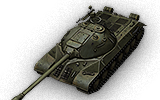Select your region to log in.
Crew:
- Commander (Radio Operator)
- Driver
- Gunner
- Loader
Advantages:
- Very tough frontal turret armor. Excellent spaced & internally angled side armor, great at reverse sidescraping
- Good mobility & low profile for a heavy tank. Pike frontal armor can give surprising bounces
- Excellent top gun high alpha damage with good penetration, gun handling and accuracy
- Tracks on the front hull count as 20mm of armor, bringing effective armor in certain areas up from ~190 to ~230
- Low profile means that face hugging and side hugging Japanese and German heavies can prevent them from hitting you
Disadvantages:
- Noticeably poor view range.
- Big lower plate that can be penetrated by many other tier 8 heavys.
- Weakspot above the gun that has only 30-50mm of armor
- Ammoracked almost frequently
Tank description:
The IS-3 is a Soviet tier 8 heavy tank.Mass production of the vehicle started in May 1945. On September 7,1945, IS-3 tanks took part in the Allied Victory Parade through Berlin. A total of 1170 vehicles were manufactured by the end of 1946, when production was canceled. From 1948 through the late 1950s, the tanks underwent a number of modernization refits.The IS-3 has more agility and speed than the German Pz.Kpfw. Tiger II, and finds itself at home engaging in close-quarters combat. While the frontal hull armor is not as thick as its German counterpart, it more than makes up for as it is sloped and the tank is agile enough to use it effectively. The front of its upgraded turret is also very well armored and has small weak points, making it difficult to penetrate. However, it cannot use this to hull down in common locations because the tank has a low profile and lacks gun depression. Instead, use rises in the ground to engineer yourself extra gun depression, or hull down behind the wrecks of enemy tanks. Another technique the IS-3 excels at is reverse sidescraping; the act of showing its side armor at an extreme angle by parking its back up against hard cover; as the front-mounted turret limits exposure from doing so. However, due to the low profile of the tank, the turret roof or engine deck can often be penetrated in this position. In addition, the IS-3 cannot use classic sidescraping techniques due to its pike nose negating the sloping of the frontal armour and forward mounted turret; doing so only exposes the already thin frontal hull at a flatter angle. Despite this, the IS-3 is a devastating tank up front when it is equipped with its top gun, boasting solid alpha damage and high penetration.The IS-3 leads to the T-10, and the Object 257.
Mass production of the vehicle started in May 1945. On September 7,1945, IS-3 tanks took part in the Allied Victory Parade through Berlin. A total of 1170 vehicles were manufactured by the end of 1946, when production was canceled. From 1948 through the late 1950s, the tanks underwent a number of modernization refits.

 Русский
Русский English
English Russian region
Russian region North-american region
North-american region European region
European region Asia region
Asia region Korean region
Korean region


 77 000
77 000
 1 424 000
1 424 000




